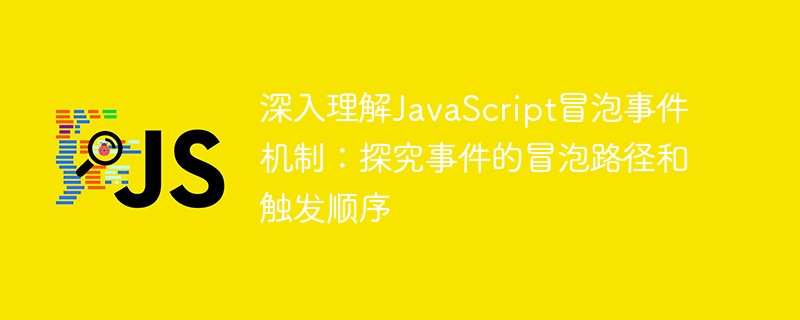Home >Web Front-end >JS Tutorial >Analysis of JavaScript event bubbling principle: explore the bubbling process and triggering sequence of events
Analysis of JavaScript event bubbling principle: explore the bubbling process and triggering sequence of events
- PHPzOriginal
- 2024-02-19 09:14:05928browse

In-depth understanding of JavaScript bubbling event mechanism: Explore the bubbling path and triggering sequence of events
In front-end development, we often use JavaScript to handle various events , such as click, scroll, input, etc. After these events are triggered, they will go through a bubbling process, starting from the triggered element and passing to the upper elements step by step until the top-most element. This article will explore the bubbling mechanism of JavaScript events in detail, including bubbling paths and triggering sequences, and deepen understanding through specific code examples.
1. What is the bubbling event mechanism?
The bubbling event mechanism is an event delivery method in JavaScript. When an element triggers an event, the event will bubble up to the upper elements starting from that element, and will be passed to the top-level element step by step. This method of event delivery allows us to capture and handle events along the entire bubbling path, not just the element that was triggered.
2. Event bubbling path
The bubbling path is the path that the event passes from the triggering element to the upper element. Each element on the path triggers the same type of event, allowing events to be captured and handled on multiple elements. The following is a schematic diagram of a bubbling path:
┌──────────┐
│ 元素 A │
└──────────┘
▲
│
┌──────────┐
│ 元素 B │
└──────────┘
▲
│
┌──────────┐
│ 元素 C │
└──────────┘
▲
│
┌──────────┐
│ 元素 D │
└──────────┘As can be seen from the figure, the event is triggered from element D, then passes through element C, element B, and finally reaches element A. This is a typical event bubbling path.
3. Trigger sequence
The trigger sequence is the sequence in which events are triggered on the bubbling path. Normally, events are triggered in order from bottom to top, that is, the event of the triggered element is triggered first, and then the events of the parent element are triggered in sequence, until the top-most element.
In order to better understand the event triggering sequence, we can demonstrate it through specific code examples. The following is a simple HTML code snippet:
<div id="outer">
<div id="inner">
<button id="btn">Click me!</button>
</div>
</div>We bind a click event to the button element and output the triggering sequence of the event in the event handler function. The following is an example of using JavaScript code:
var outer = document.getElementById('outer');
var inner = document.getElementById('inner');
var btn = document.getElementById('btn');
function handleClick(event) {
console.log(event.currentTarget.id);
}
outer.addEventListener('click', handleClick);
inner.addEventListener('click', handleClick);
btn.addEventListener('click', handleClick);In this example, we bind a click event to the outer container element outer, the inner container element inner and the button element btn. The event handler function handleClick will output the id of the triggering element of the event.
Now, let’s click the button and see the console output:
btn inner outer
As can be seen from the output, the event of the button element is triggered first, and then the inner container element events, and finally the events of the outer container element. This is consistent with the bottom-up triggering sequence we mentioned earlier.
It should be noted that in the event processing function, we can use the currentTarget property of the event object to obtain the element currently processing the event. In this way, relevant information can be obtained on the bubbling path of the event.
Summary:
Through the above analysis and examples, we have a deeper understanding of the mechanism of JavaScript bubbling events. The bubbling event mechanism allows us to capture and process events along the entire bubbling path, enabling us to develop more flexible and powerful interactivity. At the same time, understanding the bubbling path and triggering sequence of events is also very helpful for building complex interactive operations.
We hope that through the introduction and examples of this article, readers can have a more comprehensive understanding of the JavaScript bubbling event mechanism and be able to use it flexibly in actual development.
The above is the detailed content of Analysis of JavaScript event bubbling principle: explore the bubbling process and triggering sequence of events. For more information, please follow other related articles on the PHP Chinese website!
Related articles
See more- Detailed explanation of the conflict between hover and click events in jQuery (picture)
- How does html reference JavaScript? Four ways to introduce js paths in html
- How to obtain the jump path of the mini program page?
- How to change the win7 desktop file path to D drive?
- The definition and detailed analysis of bubbling events

